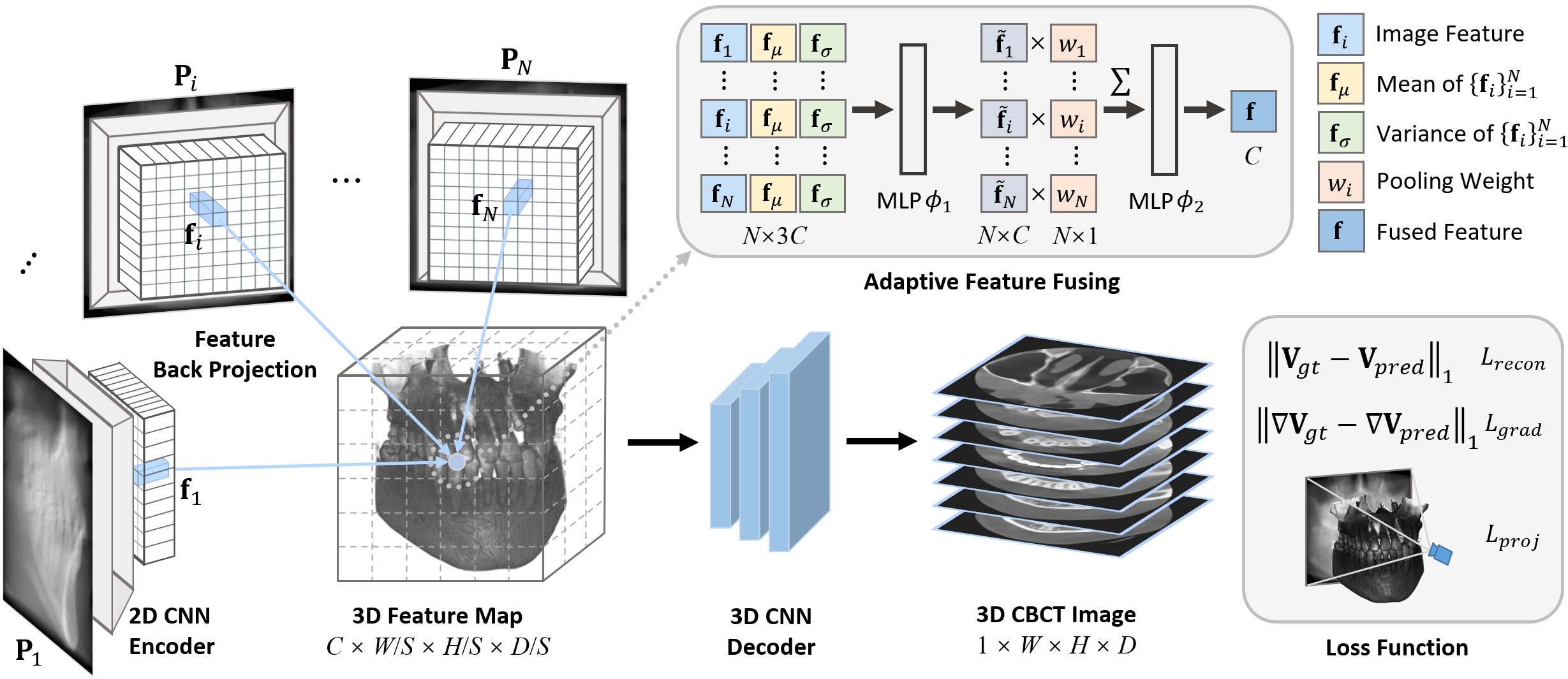Zhentao Liu, Yu Fang, Changjian Li, Han Wu, Yuan Liu, Dinggang Shen, and Zhiming Cui
Paper | Arxiv | Project Page
This is the official repo of our paper Geometry-Aware Attenuation Learning for Sparse-View CBCT Reconstruction in IEEE TMI 2024. In this work, we describe a novel encoder-decoder framework for sparse-view CBCT reconstruction which integrates the inherent geometry of CBCT scanning system. It produces high quality CBCT reconstructions with sparse input (20 views or less) in a time-efficient manner, which aims to reduce radiation exposure.
First clone this repo. And then set up an environment and install packages. We use single A100 80G GPU card for training. Make sure you have enough resources.
git clone https://github.com/Zhentao-Liu/Sparse-View-CBCT-Reconstruction.git
cd Sparse-View-CBCT-Reconstruction
conda create -n CBCTrecon python=3.8
conda activate CBCTrecon
pip install torch==2.1.2+cu118 torchvision==0.16.2+cu118 --extra-index-url https://download.pytorch.org/whl/cu118
pip install -r requirements.txt
We provide the preprocessed dental CBCT volumes in BaiduDesk. 130 cases in total, including 100 cases for training, 10 cases for validation, and 20 cases for testing. You may download them, and then put them in a self-built folder ./dataset/dental/raw_volume. As for X-ray simulation, please refer to DRR-Simulation.
As for the spinal dataset, please refer to CTSpine1K for more details. We provide the preprocessed spine CT volumes in BaiduDesk. 130 cases in total, including 100 cases for training, 10 cases for validation, and 20 cases for testing. You may download them, and then put them in a self-built folder ./dataset/spine/raw_volume. As for X-ray simulation, please refer to DRR-Simulation.
As for the walnut dataset, please refer to WalnutScan for more details. It is a large-scale real-world walnut CBCT scans dataset collected for machine learning purpose. Many thanks to this great work. We provide the preprocessed walnut CBCT volumes, real-world projections, and geometry description files in BaiduDesk. 42 cases in total, including 32 cases for training, 5 cases for validation, and 5 cases for testing. You may download them, and then put them in a self-built folder ./dataset/walnut.
Dataset link: BaiduDesk; Code: z6m7; The dataset split is set as default in ./data/dataset_split.
In our experiments, we apply Digitally Reconstructed Radiography (DRR) technique to simulate 2D X-ray projections of given 3D CBCT/CT volumes from dental/spine dataset. You need to first prepare your datasets as instructed in Dataset-Preparation. Then, run the following command.
# for dental dataset
python DRR_simulation.py --start=0 --end=360 --num=360 --sad=500 --sid=700 --datapath=./dataset/dental
# for spine dataset
python DRR_simulation.py --start=0 --end=360 --num=360 --sad=1000 --sid=1500 --datapath=./dataset/spine
In this way, you will get a data folder ./dataset/dental/syn_data or ./dataset/spine/syn_data that containing synthesized X-ray projections and geometry description files for each scanned object. It will generate 360 projections uniformly spaced within the angle range of [0, 360).
After preparing the dataset and X-ray simulation, you could run the following command to train your model.
python train.py -n=<Expname> -D=./dataset/dental/syn_data --datatype=dental --train_scale=4 --fusion=ada --start=0 --end=360 --nviews=20 --angle_sampling=uniform --is_train
In this way, you would train a model with 20 input views uniformly spaced within [0, 360) on dental dataset. The downsampling rate during training S=4, and it adopts adaptive feature fusing strategy proposed in our paper. Other hyperparameters are set as default. You may modify these hyperparamters to train your own model. The training process may take about 20 hours util convergence.
Once the above training converged, you could run the following command to evaluate your model on test dataset.
python evaluate.py -n=<Expname> -D=./dataset/dental/syn_data --datatype=dental --train_scale=4 --fusion=ada --start=0 --end=360 --nviews=20 --angle_sampling=uniform --eval_scale=4 --resume_name=200
In this way, it would test the model with 20 input views uniformly spaced within [0, 360) on dental dataset. The downsampling rate during evaluation S=4. Resumed from 200 epoch. You may modify these hyperparameters to evaluate your own model.
There may be some errors during code cleaning. If you have any questions on our code or our paper, please feel free to contact with the author: liuzht2022@shanghaitech.edu.cn, or raise an issue in this repo.
If you find this work is useful for you, please cite our paper.
@ARTICLE{SVCT,
author={Liu, Zhentao and Fang, Yu and Li, Changjian and Wu, Han and Liu, Yuan and Shen, Dinggang and Cui, Zhiming},
journal={IEEE Transactions on Medical Imaging},
title={Geometry-Aware Attenuation Learning for Sparse-View CBCT Reconstruction},
year={2024},
doi={10.1109/TMI.2024.3473970}
}
- Accurate CBCT scanning geometry description (source, detector, uvector, vvector) is inspired by WalnutScan and Astra-toolbox.
- Parts of our code are adapted from PixelNeRF implementation.
- Pioneer NeRF-based framework for CBCT reconstruction: NAF, SNAF.
- Check the concurrent work DIF-Net and its improvement C2RV which also combine feature backprojection and generalization ability to solve sparse-view CBCT reconstruction as we do.
Thanks to all these great works.

